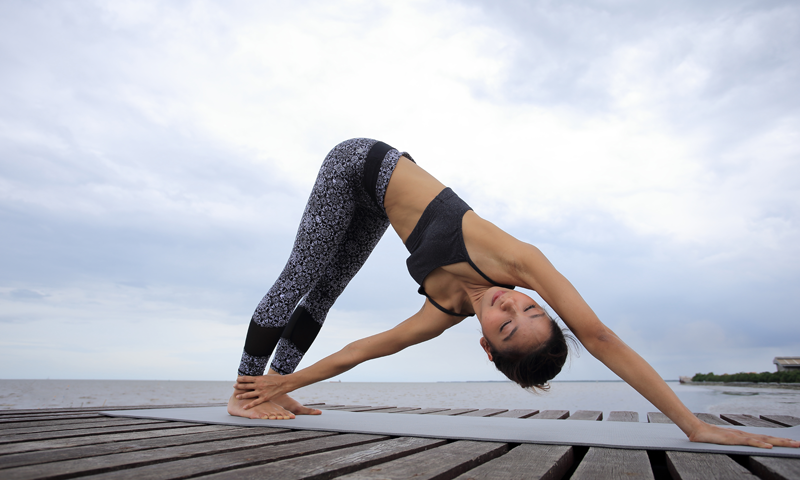
How Long Should You Practice Yoga Before Teaching?
September 5, 2019
How Can Yoga Help Business Leaders Create a World-Class Product?
September 19, 2019Does Yoga Help Increase Flexibility?

Many people avoid taking up yoga because they believe they’re not flexible enough. However, this one of the most common misconceptions about the practice. In reality, yoga doesn’t require you to be flexible enough to put your leg behind your head, or even to touch your toes. The great thing about the practice is that it increases your flexibility over time. As well as building external and internal strength, yoga increases your flexibility and helps you to find inner peace. When you first take up yoga, you don’t have to be strong, thin, or flexible; all that can be developed on the yoga mat if you so wish. In this article, we explore the question – does yoga help increase flexibility?
How Yoga Increases Flexibility
Practising yoga regularly increases your strength and flexibility while also calming the mind and working towards inner peace. While there are many styles of yoga, they all have the common goal of making the body stronger and more flexible from the inside out. Through regular practice, you can connect your body’s movement and breath and go as deep into the posture as you can. Each time you challenge your body to stretch deeper, your muscles, ligaments and connective tissue create a system of muscle memory and become more flexible.
This muscle memory tells your body that you’ve been in a certain pose before and that you can stretch yourself further into it. Yoga encourages the body to move through a range of motion and stretch the muscles and joints to move deeper into a pose. The more you practice yoga, the more flexible you’ll become. Many beginners enjoy practising in a heated studio to encourage the muscles to relax; however, practising in a regular studio, or even your living room, will have the same effect over time. Below, we explore some of the best poses to increase flexibility.
Poses to Increase Flexibility
Standing Forward Fold Pose
Standing Forward Fold increases flexibility in the lower back and hamstrings. This pose should be practised at the beginning of the session to warm up your muscles. For best results, hold the pose for a minimum of 60 seconds while breathing deeply. To begin, stand tall with your feet shoulder-width apart. Next, carefully bend at the waist and lower your upper body so it hangs forward. Allow your arms to fall to the ground. You are in Standing Forward Fold. If you cannot touch the ground when you first begin, try bending your knees slightly to make the pose easier. The more you practice, the more flexible you will become. When you’ve finished the pose, make sure to rise slowly so you don’t feel light-headed.
Standing Forward Fold with Shoulder Opener Pose
Standing Forward Fold with Shoulder Opener is similar to the previous pose but includes an additional shoulder stretch. From this asana, you’ll receive the benefits of the previous pose as well as more flexible shoulders. To start, get into Standing Forward Fold and interlace your fingers behind your lower back. Next, slowly straighten your arms and bring them over your head towards the ground. You are in Standing Forward Fold with Shoulder Opener. Make sure to move your shoulders away from your ears for maximum benefit. With regular practice, your shoulders, hamstrings and lower back will all become more flexible.

Spinal Twist Pose
Spinal Twist Pose increases flexibility in the shoulders, spine and neck. This pose may cause your back to crack, but don’t panic! As long as it’s not painful, cracking is healthy and beneficial. To start, sit on your bottom with your legs extended. Next, bend your right leg, placing your right foot flat on the ground just outside of your left thigh. Carefully manoeuvre your right hand behind you. As you inhale, use your left arm to gently hug your right knee towards your chest. When you exhale, twist your torso to your right. Take care to stretch from the base of your spine, rather than stretching from your shoulders. You are in Spinal Twist. Hold the pose 30 seconds, breathing deeply to increase the stretch. If it feels comfortable, bring your chin toward your right shoulder to deepen the stretch. After 30 seconds gently untwist and switch sides.
Easy Pose
Easy Pose is a simple way to increase flexibility in the glutes, knees and ankles. To also stretch the back, lean forward slightly while practising the pose. To begin, find a comfortable space to sit on the floor. Cross your legs at the calves, making sure that your feet are underneath your knees. Gently place your hands on your thighs. You are in Easy Pose. Breathe deeply for a couple of minutes to increase flexibility. When you first begin, your knees may be far away from the floor. If this is the case, it means your hips are tight. With regular practice, the hips will loosen and the pose with become more comfortable.
Child’s Pose
Child’s Pose stretches the quads, shoulders, shins, ankles and the lower back. For best results, hold the posture for at least 2 minutes whilst breathing deeply. Begin on all fours. Next, bring your big toes together as you spread your knees apart. Sit back on your heels and allow your upper body to rest gently on your thighs. To stretch the shoulders, reach your arms out in front of you. Alternatively, you can place your arms by your sides for a more relaxed stretch. You are in Child’s Pose. Hold the pose for a couple of minutes while allowing the body to relax.
In Summary
So, does yoga help increase flexibility? The answer to that question is a definite yes. With regular yoga practice, you can increase flexibility and strength throughout the body. To avoid injury, keep your muscles warm before you practice. If you’re attending a local class, wrap up in a yoga hoodie on your way to the studio. Providing that you warm up properly before you begin, you should receive nothing but benefits from the practice.

